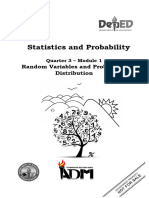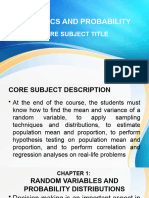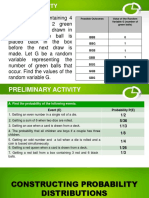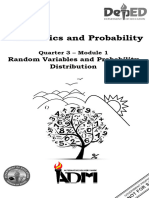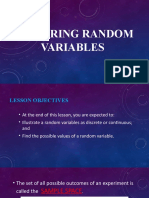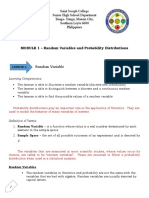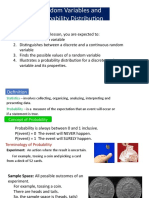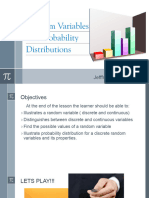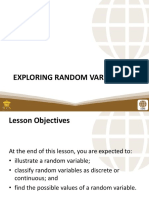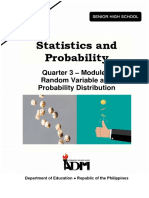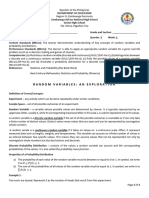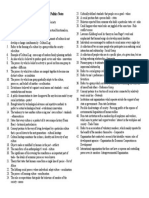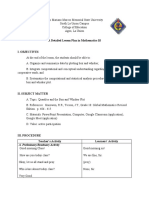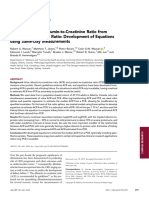Overview Number of Tails (Y) Probability
∙ Random Variables and Probability Distributions P(Y)
∙ Normal Distribution 0 1/8
∙ Sampling and Sampling Distributions 1 3/8
∙ Estimation of Parameters 2 3/8
∙ Tests of Hypothesis 3 1/8
∙ Correlation and Regression Analyses
Activity 3
Random Variables 2 balls are drawn in succession without replacement from
Sample Space an urn containing 5 red balls and 6 blue balls. Let Z be the
- the set of all possible outcomes of an experiment random variable representing the number of blue balls.
Ex. Tossing a coin, Drawing Cards Find the possible values of the random variables.
Z 0 1 2
Random Variable P(Z) 1/4 2/4 1/4
- is a function that associates a real number to each RB BR RR BB
element in the sample space. It is a variable whose values
are determined by chance. The random variable in the preceding activities are called
discrete random variables because the set of possible
Types of Random Variables outcomes is countable.
1. Discrete random variable
A random variable is discrete if it set of possible Constructing Probability Distributions
outcomes is countable. Mostly, discrete random variables
represent count data, such as the number of defective The Probability Distribution/ The Probability Mass
chairs produced in a factory. Function of Discrete Random Variable Y
2. Continuous Random Variable A discrete probability distribution or a probability
A random variable is a continuous if it takes on values mass function consists of the values a random variable can
on a continuous scale. Often, continuous random variables assume and the corresponding probabilities of the values.
represent measured data, such as heights, wights, and
temperatures. Histogram of a Discrete Random Variable Z
Activity 1
Suppose three cell phones are tested at random. We want
to find out the number of defective cell phones that occur.
Thus, to each outcome in the sample space we shall assign
a value. These are 0, 1, 2, or 3.
The number of defective cell phones is the random
variable.
To illustrate:
D - represent the defective cell phone;
Properties of a Probability Distribution
N - represent the non-defective cell phone; and
1. The probability of each value of the random variable
X - be the random variable representing the number of
must be between or equal to 0 and 1. In symbol, we
defective cell phones that occur
write its as 0 ≤ P(X) ≤ 1
DDD NND DNN NNN
2. The sum of the probabilities of all values of the
DDN NDD NDN DND random variable must be equal to 1. In symbol,
we write it as P(X) = 1
Activity 2
Suppose 3 coins are tossed. Let Y be the random variable
representing the number of tails that occur. Find the
values of the random variable Y.
HHH HHT HTT HTH
TTT TTH THH THT


